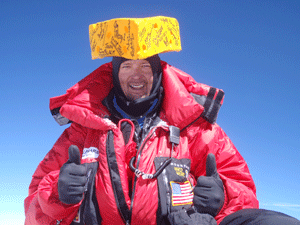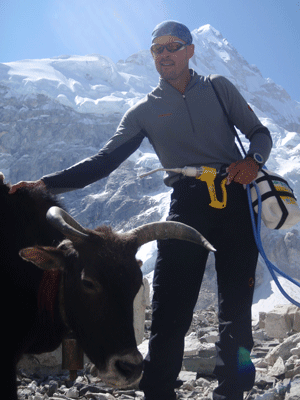Mt. Everest-Climbing Veterinarian Offers Life Lessons to Students

By Jim Dickrell, editor Dairy Today
 |
| Veterinarian Lance Fox proudly displayed his cheesehead when he reached the summit of Mt. Everest. |
On May 21, 2009, Wisconsin veterinarian Lance Fox stood at the top of the world, summiting Mount Everest and fulfilling a dream inspired both by his father's death and the birth of his pre-mature son.
Those personal events—his father died at the age of 36 when Fox was 16, his preemie son was born 12 years ago—taught Fox that life is precious, precarious, often short, and one can't assume tomorrow as a given.
It also taught him to dream, set goals, and carefully, methodically plan to achieve both.
Fox's journey to Nepal and Mt. Everest began three years ago, with practice climbs of 14,000' summits in Colorado. In 2007, he climbed Mt. Rainier in Washington state. Last year, he pulled himself up Pico de Orizaba in Mexico, the third highest peak in North America.
In his 50-day climb to the top of Everest, Fox trudged some 150 horizontal miles and clawed his way up 8.4 vertical miles of cold, unforgiving Nepalan rock. Along the way, as a technical services veterinarian for Alpharma Animal Health, Fox put his veterinary skills to work, de-worming the local yak population as a payback to local villagers and the Sherpa porters who helped with the climb.
The de-worming gave him notoriety, both among the locals and a Discovery Channel film crew who documented his team's climb. Fox, decked out in his Wisconsin cheesehead, will be featured when the documentary is aired this fall.
 |
| De-worming local yaks was part of Lance Fox's journey in climbing Mt. Everest. |
He is now part of an elite group of less than 3,000 who have reached the Everest summit since Sir Edmund Percival Hillary first reached the top in 1953.
Fox's next goal is to share his Everest-climbing journey with high school and college students around the country. Last year, Alpharma started a Reach Teach Learn (RTL) grassroots educational program to encourage students to learn about agriculture and how their food is produced. Fox will be its national spokesperson.
"My ambition as the spokesperson for RTL is to teach students that with courage and determination they can achieve anything,” he says.
RTL has two main initiatives: a student video contest and an essay contest. The video contest gives college ag students the opportunity to display their passion for agriculture by creating YouTube quality videos that depict current, ethical ag practices.
The essay portion is being launched this fall in high schools in collaboration with "Ag in the Classroom,” a USDA coordinated program. Here, students are asked to provide essays on agriculture based on selected books.
"Climbing Everest was a very rewarding experience I love sharing with kids,” says Fox. "Goal setting, discipline and achievement are all valuable life lessons. These are the same lessons that RTL students learn every day.”
The RTL contests begin this month (September) and run through mid December. For more information and contest rules visit the RTL website: www.ReachTeachLearn.com
By the way, the word from Nepal is that the de-wormed yaks are giving more milk. Fox is now making plans to get a second round of worming products shipped to the villages next year.
Find out more on the Reach Teach Learn program: www.ReachTeachLearn.com







